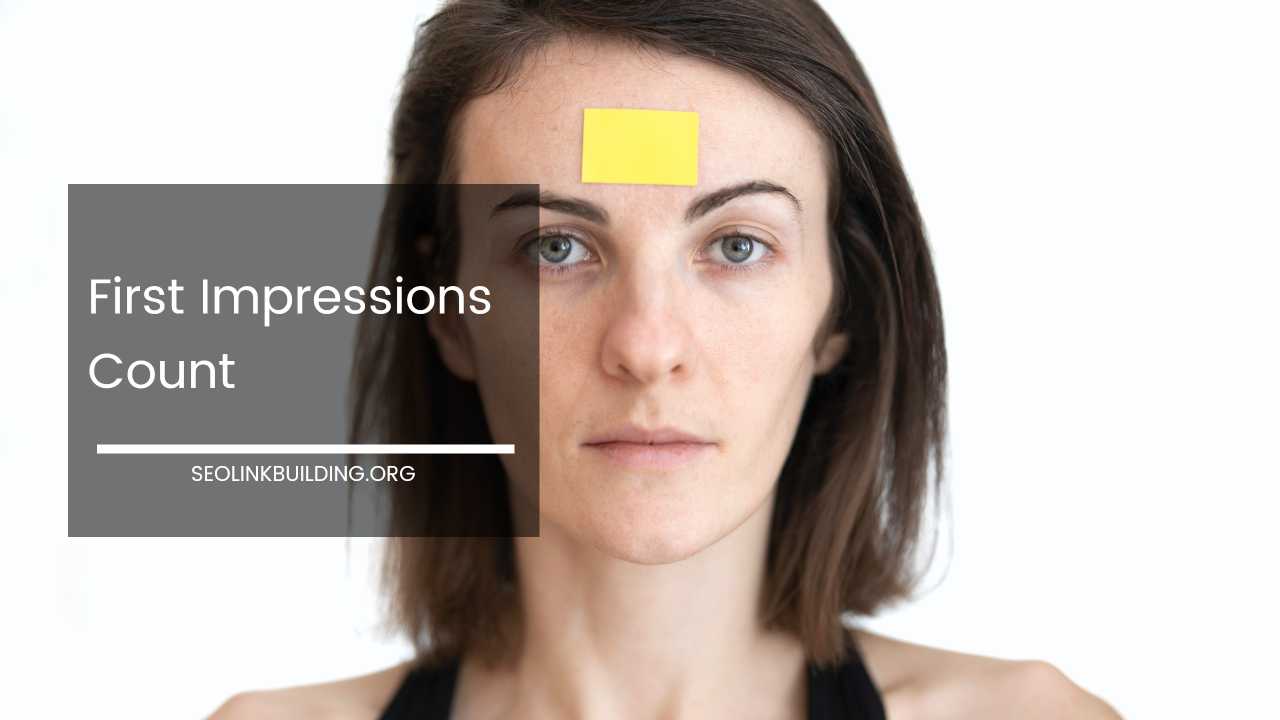Strong First Impression: Science & Strategies

First Impressions Count: The Science Behind Making a Great Impact
The Power of a Moment
In the bustling marketplace of life, first impressions are the currency of connection. Whether it’s a job interview, a first date, or a chance encounter, those initial moments hold immense power.
Studies by Princeton University reveal that it takes a mere 100 milliseconds for someone to form an impression of you.
That’s right, a tenth of a second! In this lightning-fast exchange, your appearance, body language, and even the tone of your voice are scrutinized and woven into a narrative about who you are.
This article delves into the science behind first impressions, exploring how our brains make snap judgments and how you can leverage this knowledge to create a lasting positive impact.
Remember, first impressions aren’t just about the initial encounter; they set the stage for future interactions and can influence everything from career opportunities to social connections.
The Science of Snap Judgments
Our brains are wired for efficiency. Evolutionarily speaking, forming quick judgments about strangers could mean the difference between safety and danger.
This is where the amygdala, the brain’s emotional center, comes into play. It processes sensory information rapidly, categorizing people and situations as friendly or threatening.
This primal instinct is further fueled by a phenomenon called nonverbal communication. Research by UCLA suggests that nonverbal cues account for a whopping 93% of our communication effectiveness.
This includes body language, facial expressions, and even our clothing choices. A confident posture, firm handshake, and genuine smile project trustworthiness and competence, while fidgeting, avoiding eye contact, and sloppy attire can create a negative impression.
The Confirmation Bias Trap
First impressions can be deceptive. Once formed, our brains fall prey to confirmation bias, a tendency to seek out information that confirms our initial judgment. This can lead to misinterpretations and missed opportunities.
For example, if you meet someone who seems shy during an introduction, you might interpret their silence as disinterest, further withdrawing from interaction.
In reality, the person could simply be a good listener, gathering their thoughts before speaking. This highlights the importance of active listening and allowing conversations to unfold organically.
Crafting a Winning First Impression
Creating a positive first impression requires a two-pronged approach: mastering nonverbal communication and honing your interpersonal skills. Here’s a breakdown of strategies for different settings:
-
Professional Settings:
- Dress for Success: First impressions in a professional setting are often formed within seconds. Dress professionally for the occasion, even if the company culture is casual. Aim for clothes that are clean, well-fitting, and project an air of competence.
- The Power of Punctuality: Being on time demonstrates respect for the interviewer and your commitment to the position. Aim to arrive a few minutes early to settle your nerves and gather your thoughts.
- The Perfect Handshake: A firm handshake (not crushing!) conveys confidence and professionalism. Maintain eye contact and a genuine smile while introducing yourself.
- Body Language Basics: Good posture communicates confidence and approachability. Avoid fidgeting, crossed arms, or slouching, as these can appear closed-off or nervous. Make eye contact and nod occasionally to show you’re engaged.
- Speak with Clarity: Project your voice clearly and speak at a moderate pace. Avoid filler words like “um” and “ah,” which can detract from your message.
- Active Listening: Pay active attention to what the interviewer is saying. Ask thoughtful questions demonstrating your interest in the role and the company.
-
Social Settings:
- Approachable Demeanor: Smile warmly when meeting new people. Maintaining eye contact and using open body language signals that you’re open to conversation.
- The Art of Conversation: Start with light conversation topics to break the ice. Find common ground and ask open-ended questions that encourage dialogue.
- Be a Good Listener: Show genuine interest in others. Listen actively and ask follow-up questions to demonstrate your engagement.
- Positive Reinforcement: Compliment genuine efforts and contributions of others. Positivity fosters connection and creates a lasting positive impression.
Beyond the First Moment
While first impressions are crucial, they are just the beginning of the story. Following through on your actions and maintaining a positive reputation are equally important. Here’s how to ensure your initial impression translates into long-term success:
- Deliver on Your Promises: If you commit to something, do it. Reliability builds trust and strengthens relationships.
- Maintain Positive Communication: Be clear and concise in your communication. Be respectful and avoid negativity.
- Be a Team Player: Demon – Unleash the Power of Collaboration
While the traditional image of a demon might be a solitary creature wreaking havoc, demons in professional settings can be valuable team players. Here’s how to break the mold and excel in a collaborative environment:
- Shared Goals: Remember, even demons have goals. Collaborating with colleagues to achieve shared objectives is far more effective than lone wolf tactics.
- Embrace Diverse Skills: Every demon brings unique strengths to the table. Leverage the expertise of your colleagues and be willing to learn from others.
- Offer Support: Be willing to assist teammates when needed. Sharing resources and offering expertise strengthens the collective effort.
- Healthy Competition: A little healthy competition can be a motivator, but avoid undermining or sabotaging others. Celebrate team victories and acknowledge individual contributions.
- Effective Communication: Clear communication is vital for any team. Keep colleagues informed, actively listen to their ideas, and offer constructive feedback.
By demonstrating these qualities, you can defy the stereotype of the lone demon and establish yourself as a valuable asset to any team.
- Demonstrate Professionalism: Maintain a professional demeanor in all interactions. Be respectful of colleagues, clients, and superiors.
- Embrace Continuous Learning: Never stop learning and growing in your field. Attending workshops, conferences, or taking online courses demonstrates initiative and a commitment to excellence.
- The Power of Gratitude: Expressing gratitude for opportunities and recognition goes a long way. Thank colleagues, mentors, and clients for their support.
The Art of Self-Awareness
Making a positive first impression starts with self-awareness. Reflect on your strengths and weaknesses in communication and social settings. Here are some exercises to cultivate self-awareness:
- Record Yourself: Record yourself giving a mock presentation or engaging in conversation. Watch it back and identify areas for improvement.
- Seek Feedback: Ask trusted friends or colleagues for honest feedback on your communication style and body language.
- Body Language Check: Pay attention to your body language in social settings. Are you fidgeting nervously? Do you avoid eye contact? Consciously adjusting your posture and maintaining eye contact can make a significant difference.
Cultural Considerations
The importance of understanding cultural nuances in communication cannot be overstated. Nonverbal cues and greetings can vary greatly across cultures.
Research common practices in advance of business meetings or social gatherings in unfamiliar cultural settings. This demonstrates respect and cultural sensitivity, fostering stronger connections.
The Power of Authenticity
While learning strategies for crafting a good first impression is valuable, remember that authenticity is key. The most effective way to connect with others is to be yourself. Let your genuine personality shine through while maintaining professionalism and respect.
First Impressions for Life
The science of first impressions underscores the powerful first moments we experience throughout life. By understanding how people form judgments and actively managing your nonverbal communication and interpersonal skills, you can make a lasting positive impact.
Remember, first impressions are not just about the initial encounter; they set the stage for future interactions and can shape your professional and social life for the better.
Final Word: Mastering the Art of Connection
The ability to make a positive first impression is a valuable skill that can open doors to new opportunities and strengthen your personal and professional relationships.
By leveraging the science behind snap judgments, mastering nonverbal communication techniques, and fostering genuine connections, you can transform first encounters into lasting positive impressions. So, go forth, confidently and authentically, and leave a lasting mark on everyone you meet.
Bonus Section: Actionable Tips for Making a Great First Impression
- Prepare for the Moment: Whether it’s a job interview, a networking event, or a first date, research the person or company beforehand.
- Practice Makes Perfect: Rehearse your handshake, elevator pitch, and conversation starters.
- Positive Self-Talk: Challenge negative thoughts and replace them with affirmations of confidence and capability.
- Be Present: Focus on the moment and give the person your full attention. Put away your phone and avoid distractions.
- Follow Up: Send a thank-you note or email after the initial encounter, reiterating your interest or appreciation.
By incorporating these tips into your daily interactions, you can master the art of making a positive first impression, leaving a trail of positive connections wherever you go.













